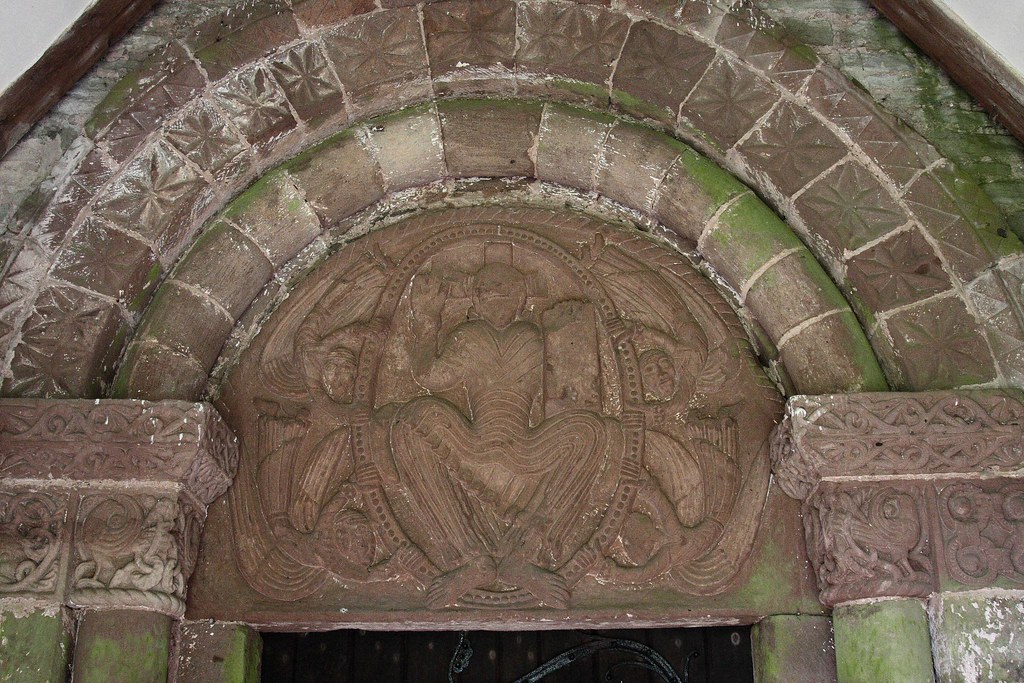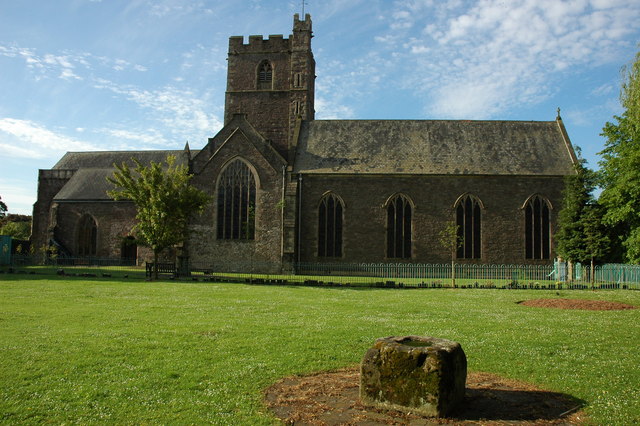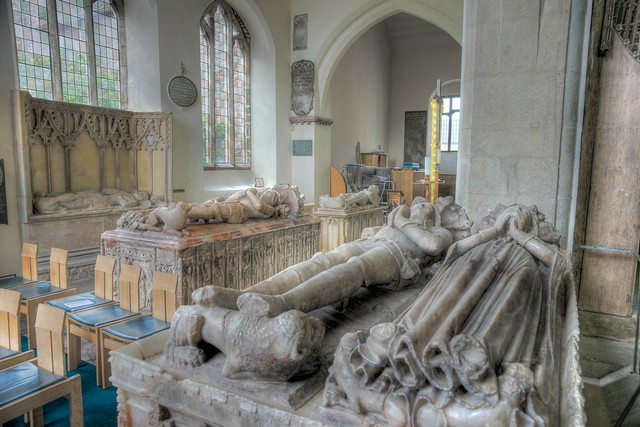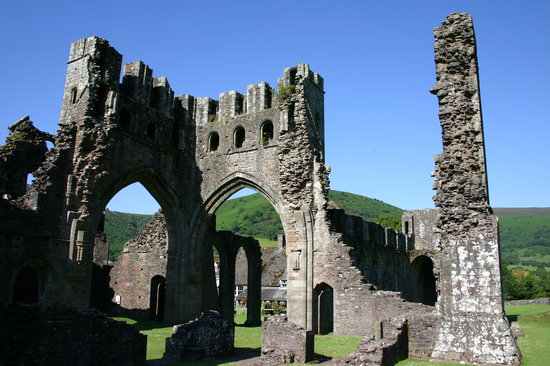Today we were blessed with even better weather than yesterday for our second day of exploration of the Herefordshire and Monmouthshire borderlands.
We began with a visit to probably the most famous church in Herefordshire, that of St Mary and St David at Kilpeck. Dated to c.1135 it is a spectacular display of sculpture from the Herefordshire school or workshop that has survived almost nine centuries due to the quality of the stone. The church is in reality smaller than I had imagined from photographs, but in all other respects more than lived up to expectations.
Kilpeck Church
The bell cote is a skillful nineteenth century addition
Image: The Sheela Na Gig Project
There is more about the church on its own website Kilpeck Church | The Church of St Mary and St David, Herefordshire and at Church of St Mary and St David, Kilpeck
The south door of Kilpeck Church
Image: kilpeckchurch.org.uk
One point that occurred to me was whether the church was originally externally rendered on the plain wall surfaces and painted probably white and the external carving picked out in colour.
On the corbel table of the chancel is one of the best known examples of a Sheela na gig ( not, of course, something one would illustrate on a family-minded blog like this ) but about which there is information at Sheela na gig, at The Sheela Na Gig Project and at Theories – The Sheela Na Gig Project. The Kilpeck example is discussed and illustrated at Kilpeck – The Sheela Na Gig Project
Adjoining the church to the west are the remains of the motte, with the remains of a shell keep, and bailey of Kilpeck castle and to the east earthworks of an abandoned part of the medieval settlement.
We then drove down and crossed over into Wales, the hills to the side of the road sculptured by nature into sugarloaf shapes that looked almost too good to be true. Our destination was the historic town of Abergavenny.
Our first visit was to Abergavenny Priory. I suppose because it is just in Wales it fails to make an appearance in books on English churches. This is a pity as St Mary's Priory deserves to be better known than I suspect it is. There is an account of it at Priory Church of St Mary, Abergavenny
Abergavenny Priory from the north
Image: Wikimedia
Abergavenny priory from the south-west
Image; The churches of Britain and Ireland
The choir of Abergavenny Priory
Image:fotolibra.com
I knew it possessed a fine set of late medieval monuments, but only a visit can do justice to the array in the south aisle or Herbert chapel of the choir. The monuments have recently undergone an extensive and careful restoration.
The view across the Herbert Chapel
Image:stacticflickr.com
Tomb of Sir William ap Thomas and his wife Gwaladys
He fought at Agincourt
Image abarothsworld.com
Sir Richard Herbert of Coldbrook, 1440-69, and his wife
He was beheaded after the battle of Edgecote
Image: HumphrysFamilyTree.com
The tomb of Richard Herbert of Ewyas
His family can be seen kneeling either side of Our Lady at the back. We speculated that her figure survived undamaged because vandals mistook her for his wife
Image: BritainExpress
A significant discovery during the restotation work was a small figure of a bedesman at the feet of one of the effigies, that of Richard Herbert of Ewyas, but concealed by the arch of the tomb recess from normal view. A copy of this is now displayed alongside the tomb.
The Bedesman
Image: Flickr Hive Mind
In addition the church possesses a remarkable and very large wooden carving of a reclining figure of Jesse, all that remains of a reredos with the theme of the Tree of Jesse. I have seen the same idea in the stone example in St Cuthbert's Wells, but had not even heard of this sculpture, let alone seen it reproduced. Once again it is areminder of what has not only been destroyed but in so many cases has also failed to leave a trace.
The figure of Jesse carved from a single trunk
Image: History Today
We then walked round to the remains of Abergavenny castle - one which I had no knowledge of - but which turned out to have substantial and interesting remains of a motte and bailey with handsome later medieval apartments in the tower of which about half survives. There is more about its history and remains at Abergavenny Castle.
Having hosted the Royal National Eisteddfod this year the town was somewhat en fete and we also managed to see where priests such as St John Kemble had celebrated Mass in the penal period.
We then drove out to the remains of Llantony Abbey - which was in fact an Augustinian priory. This is, of course, a very well known image of the dissolution of the monasteries and the day was an ideal one upon which to visit the remsains - a clear rich blue sky, warm sun, and a sense of holiday beneath the Black Mountain. There is an illustrated account of its history at Llanthony Priory
We had lunch in the pub which occupies part of the south west tower of the abbey church and the west range before exploring these striking remains of what was once a very handsome building.
Where we lunched
Image: Let's Tour England
The church from the north-west
Image:jlb2011.co.uk
Looking east along the nave to the central tower of Llantony Priory
Image: Backpackbrewer
The crossing from the north-east
Image: TripAdvisor
Looking around I began to wonder how much or how little the landscape had changed since the middle ages. Here too we encountered a real Archbishop, but that is another story...
After an ice cream to finish off our lunch in the ruins we set off north westwards up the valley. The road gets progressivly narrower and more twisting and on two occasions at least we had to reverse to allow very substantial farm vehicles through. The sheep were not so much curious as posing for photographs on the steep banks of the roadside as this wonderful twisting narrow road led us through Capel y Fin, with its memories of Eric Gill and David Jones, up eventually to the head of the valley with a spectaular view into into mid-Wales. We paused for a stroll on the hill crest before driving down towards Hay on Wye - though we avoided the potential snare of a town full of bookshops - and headed back towards Hereford along the eastern flank of the Balck Mountain.
Longtown Castle
Image:ecastles.co.uk
This took us past Longtown castle, with its early thirteenth century circular keep ( so often cited in books on castles ) and then down to Clodock.
Clodock Church
Image:PBase.com
Guinnidas' memorial to his wife
Image: Britain Express
There is an illustrated account of this attractive and very intersting church and a note about the martyred King Clydog at Clodock, St Clydog's Church. The early carvings are recorded in St Clydog, Clodock, Herefordshire · The Corpus of Romanesque Sculpture
The interior of Clodock Church
Image: Tristan Forward on Geograph
The other car went ahead but Fr Jerome and I stopped to look at the church of St Peter at Rowlstone which is dated to c.1150. This has a fine selection of carving s by the Herefordshire atelier, most notably the tympanum over the south door of Christ in Majesty.

Christ in Majesty on the Rowlstone tympanum
Image: Eric Hardy on Flickr
There are illustrated accounts of the church and sculpture at St Peter's, Rowlstone and at Rowlstone, St Peter's Church, History, Photos. There is an illustrated survey of the important carvings at St Peter, Rowlestone, Herefordshire · The Corpus of Romanesque Sculpture
We just managed to get back to Belmont for the beginning of Vespers.
Another truly splendid day out, good company, good humour, good food and a wonderfully rich assortment of medieval art and architecture.





No comments:
Post a Comment